Dr. Ken Neill, III
published in The Fisherman
A different sound gets my attention. It is a deep vibration. Overhead, I spy a dark shape silhouetted against the 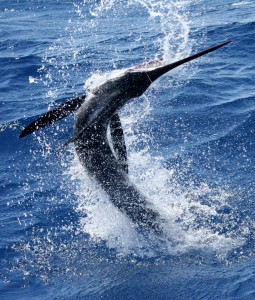 early morning light. That is where the noise is coming from. It could be a school of small fish packed together, a feeding opportunity. I rise to investigate and find a solid object. It is not a school of bait fish, held together by others of my kind, like I had hoped. I can feel the vibrations in the water. There is a lot of turbulence and bubbles trailing the object and there, I see it. Food, a small fish swimming just behind the white water. I rise to gather my meal. I grab it and turn away. Something is just not right, there is resistance. I crushed the fish as I swam off with it so that there would not be a chance of it getting away but when I try to turn it to swallow it, I cannot get it turned. I crush it again. There is a tug which gives away and now I can swallow my meal. Unknown to me, a human in the object up above has just reeled in a ballyhoo head. It is time for me to continue my search for food.
early morning light. That is where the noise is coming from. It could be a school of small fish packed together, a feeding opportunity. I rise to investigate and find a solid object. It is not a school of bait fish, held together by others of my kind, like I had hoped. I can feel the vibrations in the water. There is a lot of turbulence and bubbles trailing the object and there, I see it. Food, a small fish swimming just behind the white water. I rise to gather my meal. I grab it and turn away. Something is just not right, there is resistance. I crushed the fish as I swam off with it so that there would not be a chance of it getting away but when I try to turn it to swallow it, I cannot get it turned. I crush it again. There is a tug which gives away and now I can swallow my meal. Unknown to me, a human in the object up above has just reeled in a ballyhoo head. It is time for me to continue my search for food.
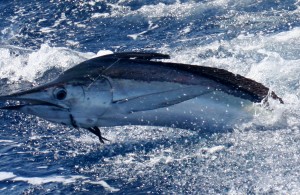 I have been cruising in these warm, near-surface waters for about an hour. It has taken that long for me to warm up from my last dive into the deep. I did not encounter any food on that dive. I am warm enough now and I head ever deeper. In these fertile waters, I dive down 20 fathoms before the cold causes me to stop. When I am in the warm, Gulf Stream, I can dive much deeper. As I reach the bottom of my dive, ahead and a little above me, I see what I have been looking for. For more than an hour, I feed on the squid that I found but now it is time to return to the surface.
I have been cruising in these warm, near-surface waters for about an hour. It has taken that long for me to warm up from my last dive into the deep. I did not encounter any food on that dive. I am warm enough now and I head ever deeper. In these fertile waters, I dive down 20 fathoms before the cold causes me to stop. When I am in the warm, Gulf Stream, I can dive much deeper. As I reach the bottom of my dive, ahead and a little above me, I see what I have been looking for. For more than an hour, I feed on the squid that I found but now it is time to return to the surface.
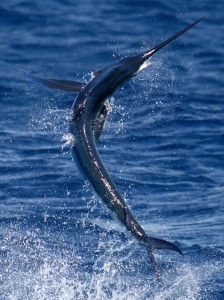 Cruising along in the warm surface waters, I find more of my kind. They have found a school of sardines. I join them in their efforts to force the school tighter together and up against the surface. One by one we head into the school and feed. By fin posture and color changes, I let the rest know that I am heading into the school. When the sardines try to go deeper, we get under them and push them back to the surface. After the school is gone, it is time to cruise again. In awhile, I will resume my dives into the deep.
Cruising along in the warm surface waters, I find more of my kind. They have found a school of sardines. I join them in their efforts to force the school tighter together and up against the surface. One by one we head into the school and feed. By fin posture and color changes, I let the rest know that I am heading into the school. When the sardines try to go deeper, we get under them and push them back to the surface. After the school is gone, it is time to cruise again. In awhile, I will resume my dives into the deep.
 Chasing white marlin with scientists like John Graves, Guy Harvey, and Andrij Horodysky has been a study in anatomy, physiology, predator-prey relationships, and oceanography. Through a combination of physical examinations, observation of feeding behavior in the wild, and the use of pop-up satellite archival tags (PSATs) much has been learned about the habits of white marlin.
Chasing white marlin with scientists like John Graves, Guy Harvey, and Andrij Horodysky has been a study in anatomy, physiology, predator-prey relationships, and oceanography. Through a combination of physical examinations, observation of feeding behavior in the wild, and the use of pop-up satellite archival tags (PSATs) much has been learned about the habits of white marlin.
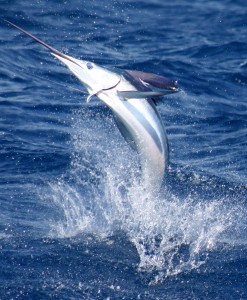 White marlin do not just swim around on the surface looking for bait. While they do spend about half of their time in the top 33 feet of the water column, looking for food may not be the primary reason they are there. This surface time may have much to do with increasing their core temperature and restoring cardiac function.
White marlin do not just swim around on the surface looking for bait. While they do spend about half of their time in the top 33 feet of the water column, looking for food may not be the primary reason they are there. This surface time may have much to do with increasing their core temperature and restoring cardiac function.
PSAT technology shows that white marlin spend much of their energy diving deep into the water column. These dives take on two characteristics. There are short-term (20 minute), V-shaped dives and there are longer (75 minute) extended U-shape dives. The assumption is that the V-shape dives occur when the fish does not encounter any food while the U-shape dives indicate a successful hunt.
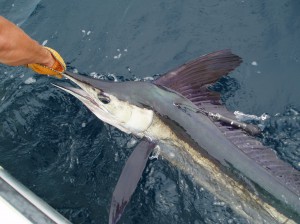 White marlin are well adapted to feeding deeper in the water column. They are not exceptional in the hearing department. They do hear better in lower frequencies and should be able to hear the deep “hum” of your engines. Their eyesight is exceptional however. They have very good low-light vision and like swordfish, they have a heating system to keep their eyes and brain warmer than the surrounding water. This allows them to see better and detect rapid motion better than their cold-blooded prey. Their field of vision is best in front and above. This means that they probably feed mostly by silhouetting their prey from down below. This is supported by the data from the U-shaped dives. On these dives, the fish reaches a maximum depth, starts to rise, and levels off at a certain depth, presumably where it is feeding. The level, feeding part of the dive is always above the deepest depth indicating that they are rising up to where they have seen their prey.
White marlin are well adapted to feeding deeper in the water column. They are not exceptional in the hearing department. They do hear better in lower frequencies and should be able to hear the deep “hum” of your engines. Their eyesight is exceptional however. They have very good low-light vision and like swordfish, they have a heating system to keep their eyes and brain warmer than the surrounding water. This allows them to see better and detect rapid motion better than their cold-blooded prey. Their field of vision is best in front and above. This means that they probably feed mostly by silhouetting their prey from down below. This is supported by the data from the U-shaped dives. On these dives, the fish reaches a maximum depth, starts to rise, and levels off at a certain depth, presumably where it is feeding. The level, feeding part of the dive is always above the deepest depth indicating that they are rising up to where they have seen their prey.
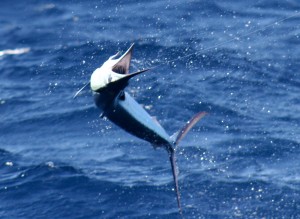 Deep-water feeding behavior is substantiated by looking at stomach contents of captured white marlin. Cuttlefish, deep-water squid, a variety of deep-water fish, and even benthic sting rays are found in the stomachs of white marlin. This deep-diving feeding pattern explains why setting swordfish long-line gear at deeper depths has not been successful at stopping unwanted white marlin by-catch. Off of Venezuela, it is common for recreational anglers to do a daytime deep-drop for swordfish. On one of our recent trips, we did this and instead of a swordfish, a white marlin ate our squid bait. Closer to home, anglers anchored on the Fingers, chunking for tuna, will be surprised when their deep bait, suspended just off of the bottom, is brought back to the surface by a sky-rocketing white marlin. This occurrence has been repeated multiple times by the tuna fleet.
Deep-water feeding behavior is substantiated by looking at stomach contents of captured white marlin. Cuttlefish, deep-water squid, a variety of deep-water fish, and even benthic sting rays are found in the stomachs of white marlin. This deep-diving feeding pattern explains why setting swordfish long-line gear at deeper depths has not been successful at stopping unwanted white marlin by-catch. Off of Venezuela, it is common for recreational anglers to do a daytime deep-drop for swordfish. On one of our recent trips, we did this and instead of a swordfish, a white marlin ate our squid bait. Closer to home, anglers anchored on the Fingers, chunking for tuna, will be surprised when their deep bait, suspended just off of the bottom, is brought back to the surface by a sky-rocketing white marlin. This occurrence has been repeated multiple times by the tuna fleet.
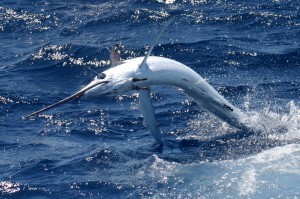 While white marlin are well adapted to feeding in the deep they are not well adapted to living there. Cardiac physiology is their limiting factor. If their core temperature gets too low, heart function will fail. Most dives will stop at the top of the thermocline. Below this, water temperature will drop much faster with further decent. White marlin studied with the PSATs stayed within 14 degrees of the surface water temperature. Depth of dives appear to be determined by water temperature rather than any particular preferred depth. Dives are deeper in the Caribbean than in the mid-Atlantic.
While white marlin are well adapted to feeding in the deep they are not well adapted to living there. Cardiac physiology is their limiting factor. If their core temperature gets too low, heart function will fail. Most dives will stop at the top of the thermocline. Below this, water temperature will drop much faster with further decent. White marlin studied with the PSATs stayed within 14 degrees of the surface water temperature. Depth of dives appear to be determined by water temperature rather than any particular preferred depth. Dives are deeper in the Caribbean than in the mid-Atlantic.
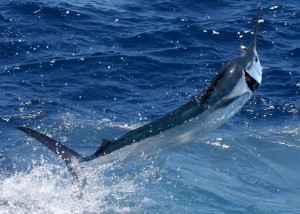 An average dive is 28 fathoms with a duration of 40 minutes. Many dives will exceed 55 fathoms and some will go well over 100 fathoms. The average dive in the mid-Atlantic will be about 21 fathoms in depth. The time between dives will be longer in the mid-Atlantic than in southern waters. Colder waters take longer to warm the fish back up. White marlin will make these dives throughout the day and night. The successful, U-shaped dives are more prevalent during the daytime and nights with bright moonlight. Under these conditions it is easier for the fish to silhouette their prey.
An average dive is 28 fathoms with a duration of 40 minutes. Many dives will exceed 55 fathoms and some will go well over 100 fathoms. The average dive in the mid-Atlantic will be about 21 fathoms in depth. The time between dives will be longer in the mid-Atlantic than in southern waters. Colder waters take longer to warm the fish back up. White marlin will make these dives throughout the day and night. The successful, U-shaped dives are more prevalent during the daytime and nights with bright moonlight. Under these conditions it is easier for the fish to silhouette their prey.
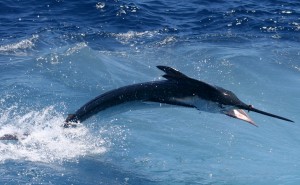 What does this mean for anglers? It is always good to have a better understanding our quarry. Understanding that marlin are searching for food farther down in the water column means that while we are out there bottom fishing for tilefish or drifting for swordfish it is a good idea to suspend a live mullet or rigged squid about 20 fathoms down. A white marlin is a good addition to any day’s catch. Trolling ballyhoo on the surface works, so there is no need to change our tactics, but we can add to them.
What does this mean for anglers? It is always good to have a better understanding our quarry. Understanding that marlin are searching for food farther down in the water column means that while we are out there bottom fishing for tilefish or drifting for swordfish it is a good idea to suspend a live mullet or rigged squid about 20 fathoms down. A white marlin is a good addition to any day’s catch. Trolling ballyhoo on the surface works, so there is no need to change our tactics, but we can add to them.
PSAT technology tells us other things about white marlin. While they spend much of their time making vertical dives, they do make significant horizontal movements during a day’s time. Average movement during a day covers 15 nautical miles (NM). The largest movement was 63 NM in a 24 hour period. White marlin spend 85% of their time in water from 75 to 84 degrees. You should spend your time looking for them in waters within this temperature range. These tags also tell us that most white marlin will survive the catch and release process. You can help their chance of survival by treating them gently, leaving them in the water rather than bringing them on-board for a photo opportunity and by using circle hooks. White marlin caught on J-hooks and released have a 35% mortality rate while those caught on circle hooks only have a 1.7% post-release mortality rate.
White marlin are not a schooling fish. They do not mimic each others’ movements like a school of fish or a flock of birds will. The scientists call them “non-polarized aggregators”. They probably spend much of their time feeding alone but will join in packs when the opportunity arises. Guy Harvey’s film footage of white marlin feeding on bait balls in the wild clearly shows that these fish will group together and appear to work together during this type of feeding opportunity.
This is when the white marlin bite is fantastic. Large numbers of white marlin in a small area, feeding with a pack mentality, makes for some of the most exciting fishing possible. Now you have the chance to fill your riggers with release flags. Here in the mid-Atlantic, we have white marlin available May through October but this magic fishing opportunity exists for a much shorter period of time. August and September are the months when you will find packs of white marlin aggressively feeding in our ocean waters.
For more information on the scientific research being done with white marlin and other fish, visit: http://www.vims.edu/about/directory/faculty/graves_je.php
